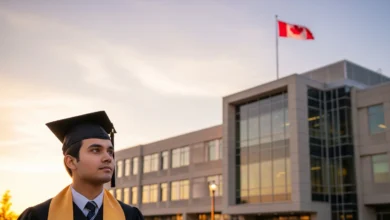Guide to Student Visa Sponsorship for Studying Abroad

Your Comprehensive Guide to Securing Student Visa Sponsorship
Embarking on an international education journey is a thrilling prospect, but navigating the complexities of immigration can be a significant hurdle. At the heart of this process lies student visa sponsorship, a crucial endorsement that validates your academic intentions and grants you legal access to study in a foreign country. This in-depth guide will demystify the concept of visa sponsorship, outline your options, and provide actionable steps to ensure your application is successful, paving the way for a seamless transition to studying abroad.
What is Student Visa Sponsorship and Why is it Essential?
Student visa sponsorship is a formal declaration from a recognized entity—such as a university, government body, or employer—to the immigration authorities of a host country, confirming your legitimacy as a student. This sponsorship is the bedrock of your visa application, demonstrating that you have a valid reason for entry and the necessary support structure for your stay.
The importance of securing sponsorship cannot be overstated. It significantly boosts your visa approval chances by providing official verification of your academic enrollment and financial stability. Moreover, it ensures you remain compliant with the host country’s immigration laws, safeguarding you from potential legal complications. For many aspiring international students, a sponsorship is not just a facilitator but a fundamental requirement for turning their dream of studying abroad into a reality.

Key Sponsorship Pathways for International Students
Understanding the different sponsorship avenues available is the first step toward identifying the best fit for your academic and financial circumstances. Each option comes with its own set of processes, benefits, and obligations.
1. University Sponsorship: The Standard Route
For the majority of international students, the educational institution they are enrolled in acts as their primary sponsor. Once you receive an offer of admission from a designated learning institution, the university will provide you with the necessary official documentation, such as a Certificate of Eligibility (like the I-20 form in the US) or a Confirmation of Acceptance for Studies (CAS in the UK).
- Process: The sponsorship is directly tied to your admission and enrollment. The university will guide you on the specific documents needed, but the onus of completing and submitting the visa application rests on you.
- Key Consideration: Your sponsorship is contingent upon maintaining your student status. Any changes to your enrollment, such as dropping out or failing to meet academic requirements, can lead to the revocation of your visa.
2. Government Sponsorship: Prestigious and Supportive
Government-funded scholarships and exchange programs are excellent sponsorship opportunities. Often highly prestigious, these sponsorships can cover tuition, living expenses, and even travel costs. They are typically offered through bilateral agreements between countries to foster international cooperation and knowledge exchange.
- Process: Securing a government sponsorship often involves a competitive application process based on academic merit and other criteria. Successful applicants receive an official sponsorship letter to be included in their visa application.
- Key Consideration: These sponsorships may come with specific conditions, such as a requirement to return to your home country for a certain period after graduation to contribute to the local workforce.
3. Employer Sponsorship: Gaining Practical Experience
For students participating in internships, co-op programs, or work-study arrangements, an employer can act as a sponsor. This pathway is invaluable for gaining hands-on industry experience while you study and can provide significant financial relief.
- Process: Once you secure a position with an eligible employer, they will issue a formal employment contract or a sponsorship letter detailing the nature of your work, its duration, and its relevance to your field of study.
- Key Consideration: The visa tied to this sponsorship is typically temporary and linked to the duration of your work placement. It’s crucial to ensure the work component is an integral part of your academic program.
4. Private Sponsorship: A Niche Alternative
Less common but equally impactful, private sponsorships are offered by non-profit organizations, foundations, corporations, or individuals. These sponsors often focus on supporting students in specific fields of study, such as environmental science, public health, or the arts.
- Process: Finding and applying for private sponsorships requires thorough research. These opportunities are often highly targeted, and you will need to meet very specific eligibility criteria.
- Key Consideration: Private sponsorships can offer tailored support, including mentorship and networking opportunities, but they may require a strong commitment to the sponsor’s mission and regular progress reports.
Navigating the Visa Sponsorship and Application Maze
Securing sponsorship is a multi-step process that demands careful planning and attention to detail. A methodical approach will significantly increase your chances of success.
Step 1: Secure Your Sponsorship
- For University Sponsorship: Apply and get accepted into your chosen institution. Fulfill all admission conditions and pay any required deposits to receive your official sponsorship documents.
- For Government Sponsorship: Research and apply for eligible government scholarships. A compelling application highlighting your academic achievements and future aspirations is key.
- For Employer Sponsorship: Actively seek out internship or work-study opportunities with companies that have a history of sponsoring international students. Leverage your university’s career services.
Step 2: Fulfill the Core Requirements
While specific requirements vary by sponsor and country, several universal prerequisites must be met:
- Academic Credentials: Provide official transcripts, diplomas, and standardized test scores (e.g., TOEFL, IELTS, GRE, GMAT) that meet the required benchmarks.
- Financial Proof: Demonstrate your ability to cover tuition fees and living costs for the duration of your studies through bank statements, scholarship letters, or a sponsor’s affidavit of support.
- Valid Passport: Ensure your passport is valid for the entire duration of your intended stay.
- Health and Medical Clearance: Undergo any required medical examinations and obtain necessary vaccinations. Proof of health insurance is often mandatory.
- Legal Documentation: Complete all visa application forms accurately and honestly. You may also need to provide police clearance certificates.
Step 3: Ace Your Visa Application
Once you have your sponsorship confirmation and have gathered all necessary documents, you can proceed with the formal visa application.
- Gather Your Documents: Create a comprehensive checklist to ensure you have all the required paperwork, including your passport, sponsorship letter, financial evidence, academic records, and application forms.
- Submit Your Application: Follow the host country’s specific application procedure, whether it’s an online portal or an in-person appointment at an embassy or consulate. Pay all associated fees.
- Prepare for an Interview: Some countries require a visa interview. Be prepared to articulate your academic goals, your reasons for choosing the specific institution and country, and how you plan to finance your education.
- Track Your Application: Use the provided tracking number to monitor the status of your application. Respond promptly to any requests for additional information.
Pro Tips for a Successful Sponsorship Journey
- Start Early: The entire process, from applying to institutions to receiving your visa, can take several months. Begin at least 6-12 months before your intended start date.
- Seek Expert Guidance: Utilize the resources available at your university’s international student office. Their advisors can provide invaluable guidance on sponsorship and visa procedures.
- Maintain Open Communication: Keep your sponsor informed of any significant changes in your circumstances. A transparent and proactive approach builds trust.
- Be Meticulous with Paperwork: Double-check that all your documents are accurate, consistent, and complete. Inconsistencies can lead to delays or rejection.
- Create Digital Backups: Scan all your important documents and keep digital copies in a secure cloud storage service.
Life After Visa Approval: Maintaining Your Status
Receiving your student visa is a monumental achievement, but your responsibilities don’t end there. To maintain your legal status in the host country, you must adhere to the conditions of your visa sponsorship. This includes maintaining satisfactory academic progress, complying with local laws, and adhering to any work limitations.
By understanding the intricacies of student visa sponsorship and diligently following the required steps, you can confidently navigate the path to your international education. This foundational process not only grants you legal entry but also sets the stage for a rewarding and successful academic experience abroad.
Disclaimer:
This guide provides a general overview of the concept of student visa sponsorship and is intended for informational purposes only.
Please be aware that student visa and sponsorship laws, requirements, and application processes vary dramatically from one country to another. The information presented here is general in nature and may not be applicable to your specific destination country.
This content is not a substitute for official legal or immigration advice from a qualified professional or government authority.
Before taking any action, you MUST consult the official government immigration website and the specific embassy or consulate of the country you plan to study in for accurate, up-to-date, and legally binding information.
Reliance on the general information in this guide is solely at your own risk.




